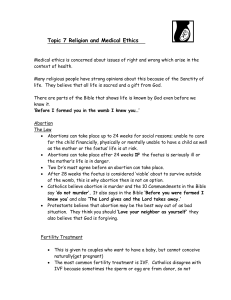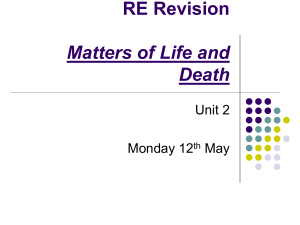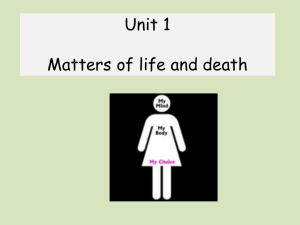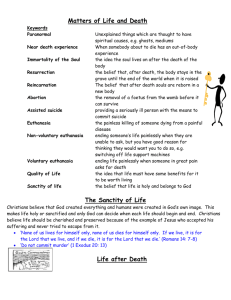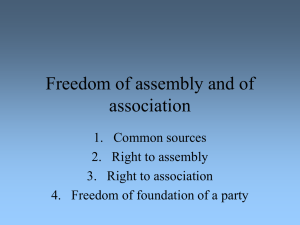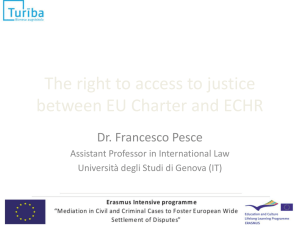Right to life - halmaigabor.hu
advertisement
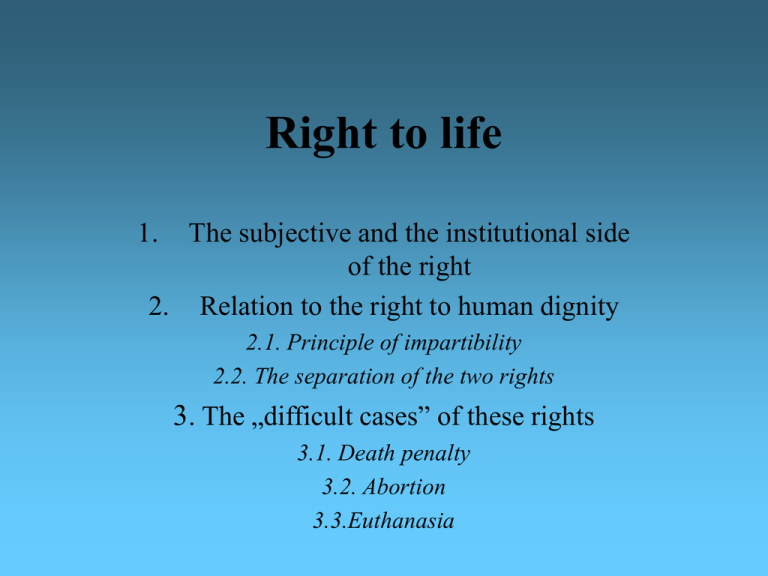
Right to life 1. The subjective and the institutional side of the right 2. Relation to the right to human dignity 2.1. Principle of impartibility 2.2. The separation of the two rights 3. The „difficult cases” of these rights 3.1. Death penalty 3.2. Abortion 3.3.Euthanasia Constitution Article 54 para. (1) right to life and human dignity the most fundamental, relation Preamble of UN Universal Declaration Article 1 EU Charter of Fundamental Rights ECHR Article 2 1. The subjective and the institutional side of the right Negative side: against state • European Court of Human Rights (ECtHR): Case of McCann • Constitutional Court of the Republic of Hungary(MKAB): absolute fundamental right no necessity-proportionality test - marginal cases: death penalty, abortion, euthanasia - military oath, conscript demolition expert - gun licence right to self-defence - police handling of gun - (shooting down terrorist plane) Institutional side: state’s obligation of protection of life • US: DeShaney • G: Schleyer • ECtHR: Velikova • MKAB: Constitution Article 8 para. (1) objective obligation of state (Decision 64/1991 AB) 2. Relation to the right to human dignity 2.1. Principle of impartibility • BVerfG: dignity goes with life but not absolute right • MKAB: impartibility absolute right monistic human view (unity of body and soul) dualistic human view 2.2. The separation of the two rights - legal positivism moral choice from worths (A. Takács, B. Pokol) - different moral approximation ideological neutrality of state „ sanctity of life” Dignity can’t be restricted BUT taking away of life is legitimate in extraordinary situation, not arbitrary, namely it doesn’t go necessarily with injury of dignity • justifiable defence • emergency • better to die (euthanasia) • it depends on her/his whether somebody stay alive 3. The „difficult cases” of these rights 3.1. Death penalty • ECHR Additional Protocol 6 (1983): prohibition in peace • International Covenant on Civil and Political Rights facultative Additional Protocol 2 (1989) • EU Charter of Fundamental Rights Article 2 para. (2) + Article 19 para. (2): prohibition of the event of extradition • ECHR Additional Protocol 13 (2002): prohibition at all times • US Constitutional Amendment 14 – due process + Constitutional Amendment 8 – „ prohibition of inhuman and uncommon penalty” - Furman v. Georgia (1972): arbitrary and discriminating court practice - Gregg v. Georgia (1976): new rules -reason • ECHR: Case of Soering (1989): death-row syndrom no extradition • Hungary, South-Afrika, Lithuania, Ukraine: decisions of Constitutional Court • MKAB: Decision 23/1990 AB - Constitution Article 54 para. (1) permit - Constitution Article 8 para. (2) prohibit - lex posterior derogat priori (?) - majority of 8:1 * impartible, unrestrictable fundamental right * have no effect of development of deliquency * international legal conventions - Dissenting opinion of P. Schmidt: collision of Articles 8 and 54 - Concurring reasonig of T. Lábady, Ö. Tersztyánszky: also on the basis of Article 54 - Concurring reasonig of L. Sólyom: „always arbitrary” contravene Article 54, too - A. Szabó:proportional, repressive theory of punishment talion - J. Zlinszky: preventive theory lack of repressive effect Prohibition of referendum: Decision 11/1999 AB 3.2. Abortion Pro choice (ability of self-determination) pro life (theory of creation) Compromises: - dated model - indication model crisis indication • US: Roe v. Wade (1973) unconstitutional act in Texas - privacy:Constitutional Amendment 14 and 9: right of woman to decide – trimester regulation Webster (1989), Casey (1992) • G: BVerfG 1. (1975) right of foetus to life (conception and 14th day) homicide BVerfG 2. (1993) unconstitutional that abortion without indication isn’t illegal BUT criminal impunity after advising • Ireland: radical opinion about protection of foetus only life of mother • ECHR: - Brüggemann (1977) right of foetus to life ? - X. v. UK: right of foetus?, right of women to privacy - H.v. Norway: margin of appreciation • MKAB: - Decision 64/1991 AB: formal violation of constitution content: two oppurtunities of legislature concurring reasonig of T. Lábady: „ innate right” right to life from conception - Act LXXIX of 1992: 12 weeks, acute crisis - Case of Dávodi: contingent legal capacity - Decision 48/1998 AB: advising instead of symbolic indication dissenting opinion of T. Lábady, concurring reasonig of A. Holló 3.3.Euthanasia Voluntary – non-voluntary, passive – active, direct – indirect US: refusal of provision informed consent - Case of Cruzan: lack of unambigious and strong evidence - Kevorkian - State Oregon - „mimimalism” of SC legislation of member states ECHR: Case of Pretty (2002) no right to death The Netherlands, Belgium: active euthanasia Hungary: - Supreme Court: Case of Binder - Act on public health: conditions of refusal of treatment - Decision 22/2003 AB * passive euthanasia = part of right to self-determination, which can’ t be curtailed totally * dissenting opinion of M. Bihari, A. Holló, I. Kukorelli * active euthanasia: no absence Thank you for your attention!


